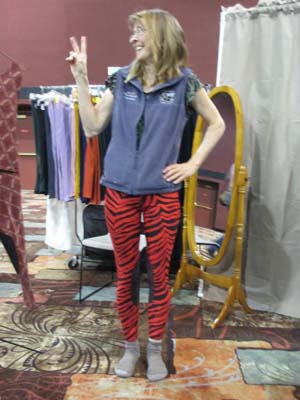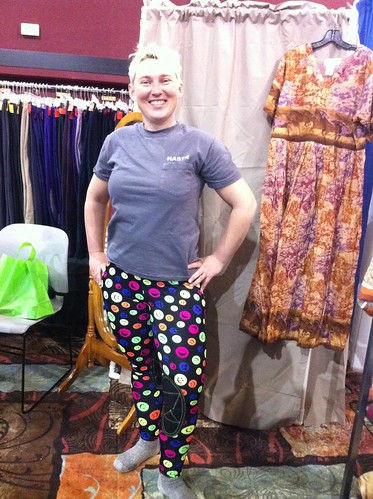
Wednesday March 14 2012
It's hard to say what the very best part of the AERC Convention was.
It could have been the trade show, where you could find everything you needed, and everything you didn't need, from saddles to feed supplements and everything in between. The number of booths was down this year, but the shopping looked pretty brisk. Maybe you didn't really need, say, a new pair of tights, but Evelyn was there with her practical, colorful, and wild and fun tights, and who can pass up a pair of tights like this? (Don't blame me, red is Jose's color!)

Funder got her own great pair of tights,

as did Steph:

Authors Julie Suhr ("…but it wasn't the horses's fault!")

and Sharma Gaponoff ("Tevis, From the Back of My Horse") were both there selling and autographing their books.

Jose won a new saddle pad from Specialized Saddles! (It's been too hurricane-windy or too Seattle-rainy since we've been home from the Convention for Jose to try it out, and anyway, he might share it with his pal Mac.)

The Hot Topics sessions are always hopping. Anybody can sit in and put their two cents in on everything from trail closures to membership drives. It's a good forum for good ideas to be discussed. Former World Champion endurance rider Valerie Kanavy had the most common sensical thing to say that I have heard in a long time: Where are all our endurance riders? Where are our kids and juniors? Go to an endurance ride just about anywhere in the world, and you see double and triple the number of riders there, including families (and the entry fee is about double the price as here in the US).
We all need to stop belittling people who 'only' ride 25 miles because 'that's not endurance' because, as Valerie said, they contribute just as much to participation in the rides (sometimes more) and entry fees, which allows her to continue doing the 100-mile rides she loves to do. We need to make our sport more accessible to younger riders and families - put on the 12-mile introduction ride, or, have AERC consider even requiring the completion of a 12-mile ride before throwing the first-timer and her 12-year-old straight into a 25-mile endurance ride. "We need to think outside our box," Valerie said, and she's right.
We need to welcome people, instead of excluding them and hoarding ourselves into little cliques just because 'they' don't do the distance we personally like to do, or the distance that we think defines endurance riding. That person who likes to 'only' ride 25 mile rides this season may become next season's National 100 Mile Award winner. That first-time Junior that rides 12 or 25 miles might be the next National Mileage Champion and new ride manager who puts on new endurance rides for people who like to ride. What we're doing to recruit new riders is not particularly a raging success, especially if we don't fit fit them into our self-made categories - maybe it's time to try something else.
There were some excellent lectures over the weekend. Steph will report on Friday's lectures. On Saturday, Jeanette Mero talked about metabolics, and Susan Garlinghouse spoke about dehydration in endurance horses. I learned a few things - one being that I never want to override my horse so that he has a metabolic problem, but that despite your best precautions, it can happen to anybody. I did once have to deal with a badly colicking horse, far out on trail, and it was a dreadful experience. He hadn't been overridden and he was on his home trails - for the first time in his long career, it just happened. (He lived.)
When you ask your horse to do 50 miles and up, you are pushing that envelope, and the harder you push him, the more you are asking, but you just don't know exactly where that precipice is on that given day until you've irreversibly crossed it.
Fluids, fluids, fluids, Jeanette emphasized, if your horse gets into trouble. Using a lot of fluids immediately at the first sign of trouble has been proven to reverse a majority of metabolic issues. The longer you wait, the more risk to your horse, and, often, the (much) more expense involved because it usually ends up in a trip to the horse hospital and a possibly long recovery. And we need to all get over the stigma we've created about a horse that needs fluids. It can happen to anybody, and it's the welfare of the horse that is paramount. Many horses participating in international 160-km competitions around the world routinely receive fluids before and after their rides as a precaution to rehydrate them.
Fluid treatment itself is not cheap at a ride - $400 to $800 - but Jeanette felt you owe it to your horse to commit to that level of treatment, if your horse gets into a bad situation, especially when this has a good chance of solving the problem.
I agree. We ask a lot of our endurance horses, and when you spend all the months or years training and conditioning your horse, feeding him, thinking of him as part of your family (or as the working part of the equation who supports your hobby), paying for the vet care, shoeing, owning the truck and trailer, traveling to the rides, paying the entry fees, the least you can do for that horse in trouble is commit to that first immediate level of care, if he needs it. It's only right.
Long-time high-mileage endurance riders Robert and Melissa Ribley gave an excellent presentation of AERC - the way we were and the way we are, looking back at some of the pioneering people and rides in the AERC organization.

Some of our top-level Junior and Young Riders gave a talk about their participation in December's Young Riders & Juniors World Endurance Championship held in Abu Dhabi, where 3 of the 3 US riders finished, and the USA team came in 4th. This was an outstanding finish, as the 'team' had been thrown together with not much preparation, unlike the Uruguayan team (1st place) and French team (2nd place) that had been working toward this goal all year.

New USA chef d'equipe Emmett Ross gave a talk on the future of the USA team and this year's World Endurance Championship coming up in Great Britain in August.

Friday night the Western States Trail Foundation had drinks and hors d'oeuvres accompanied by videos from the Tevis trail, and Barbara White announced an exciting new development for this year's Tevis: the Legacy Buckle program. First-time Tevis riders can opt to receive a historic buckle from someone who completed decades ago. The buckle will be engraved with the rider’s name, horse’s name, and year of finish and will be awarded to you at no charge. Just think - you could be the recipient of a belt buckle previously won by the likes of Julie Suhr, or Barbara White, or Donna Fitzgerald!

The Saturday night awards dinner (you can see some of the awards here) was a just good time, with worthy people and horses receiving very worthy awards, particularly the Pardner's Award (Karen Fredrickson and MRR Pyro (Murphy)), the Perfect Ten Award (Karen Fredrickson and MRR Pyro (Murphy)!), and the National Mileage Championship. This is what American endurance riding is all about - longevity, and riders who know how to take care of their horses over thousands of miles and many, many years.
The best part of the convention possibly could have been seeing so many friends with a common passion and hobby, gathered in one place, putting names to faces, meeting waaaaay too early for breakfast in the morning without a prior shot of caffeine, trying to make your way somewhere but never making it there because you run into too many people to talk with, having dinner with friends - and through it all, everybody talking horses. Just getting to see and hug some of your favorite horse people on the planet might just be enough reason to spend a weekend at the AERC Convention in Reno. Thanks to the AERC staff for the hard work in putting on such a good event.
As a suggestion, the only thing that might improve the Convention would be if we could bring all our horses along for their own convention. But then - we'd all have to saddle up and go for an endurance ride, wouldn't we?
[slide show here]
No comments:
Post a Comment